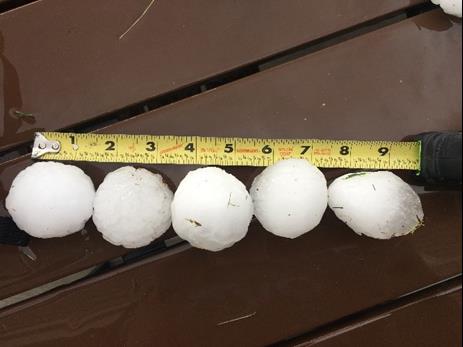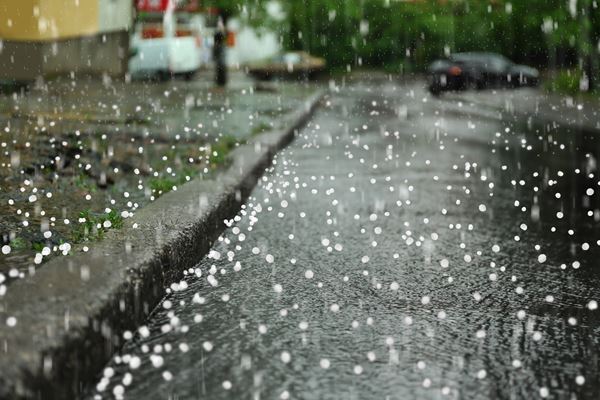What the Hail? The Basics of Assessing a Property for Hail Damage
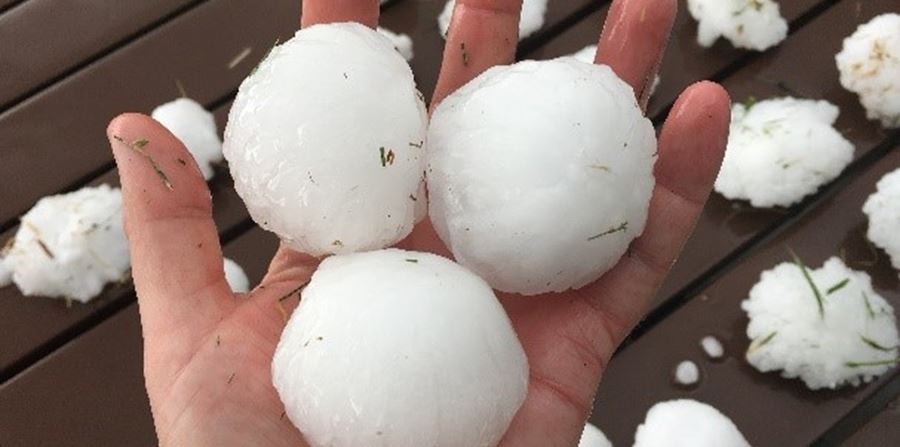
While many locales across the United States are very accustomed to hailstorms, much of the country is not used to Mother Nature pelting them with an onslaught of ice balls each spring. Assessing property for hail damage is not rocket science, however, having a basic knowledge of how to properly assess a site for hail exposure can prevent missing hail-related damage or misidentifying damage that is not hail-related during an assessment.
Over the past few days New York City, Boston, and Washington D.C., three areas not typically impacted by hail, experienced various Level 1 (low severity) hailstorms. While these storms were not catastrophic in nature, they may still cause a surge in insurance claims made by homeowners worried that their home or property was damaged by the onslaught of ice balls, and though there may be very little hail damage caused by these hailstorms, there may be pre-existing damage that is mistaken for being hail-related if not assessed by a trained eye.
How to Identify the Size of Hail Damage on Your Roof
Hail density varies, meaning that the same size hail could be a slush ball causing no damage or hard as a rock causing lots of damage. Throw in wind speed and angle and it’s the difference between a four-year-old lobbing a baseball and a 17-year-old throwing a baseball. Next up is what you’re hitting. Some things hold up better, like your concrete sidewalk where no damage should occur. If the same hail hits your window your window can shatter; your car could create a ton of dimples/indentations; a wood fence picket a couple of dents, nothing at all, or break off a piece depending on the shape of the wood fence. The material, thickness, and condition of what is being struck make a big difference.
Using evidence on site to try and estimate the size of hail that property was exposed to can be useful when trying to determine what building materials may or may not have been damaged by the hailstorm. The way to accomplish this is not to pull some sort of online weather report for the general vicinity, but rather to use the evidence on site.
The best way to determine the size of the hailstones that impacted any given property is by measuring spatter marks. Spatter marks are aesthetic blemishes commonly created by hailstone impacts, which are characterized by the removal of microbial growth and/or oxidization of the material surface resulting in anomalies that vary in color when compared with adjacent areas that were not impacted by hail. Spatter marks are temporary aesthetic conditions that will fade over time and do not constitute damage to oxidized metal and wood surfaces. Although not considered damage, these spatter marks can provide an indicator of the size and directionality of recent hail.
As shown in the photos below, a spatter mark is typically shaped somewhat like an asteroid flying through space. They typically have a rounded head caused by the first impact of the hailstone and a fleeting tail caused by the hailstone breaking apart upon impact. The best way to approximate the size of the hailstone is to measure the diameter of the rounded head of the spatter mark.
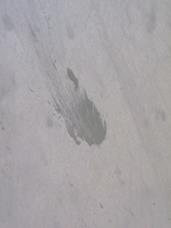 |
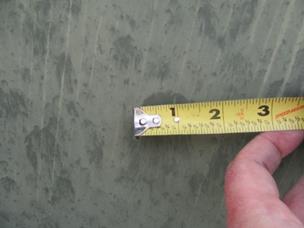 |
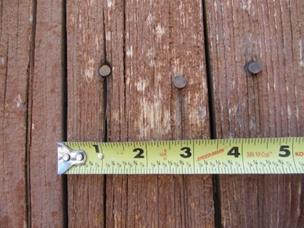 |
By knowing the approximate diameter of the hailstones the property was exposed to, one can then begin to make educated determinations as to what materials might have been damaged by the hailstorm.
How to Perform a Hail Damage Assessment on Property
In addition to determining the size of the hailstones that were experienced on-site, spatter marks are a great way to determine the directionality of a hailstorm. Typically, storms move through an area in a particular direction, and as such, it is common for the damage created by the hailstones contained within a storm system to impact either one or perhaps two adjacent elevations across any given property. While all horizontal exposures are typically impacted, vertical or partially vertical exposures (i.e. walls and roof facets) are typically impacted more severely by the storm if they directly face the oncoming storm.
For example, if a hailstorm is moving in a west-to-east fashion, as demonstrated below, typically the vertical elevations/facets facing west will be most severely impacted by the storm, while the vertical elevations/facets facing east will endure little to no damage as demonstrated below. This occurs because the trajectory of the hailstones is more perpendicular to these surfaces and thus, more energy is imparted to the material by the hailstone. Surfaces that are less perpendicular and more parallel to the hailstone’s trajectory typically receive a glancing blow from the hailstone, with much less energy imparted at impact.
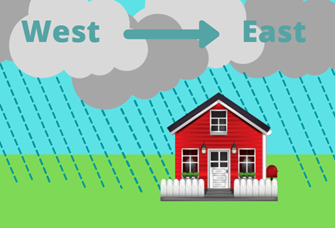 |
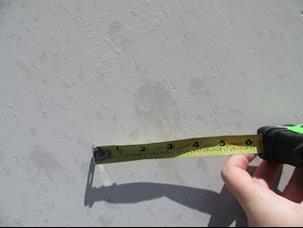 |
The directionality of a hailstorm can be determined not only by assessing the building elevations for evidence of hailstone impacts, such as circular indentations in metals, circular or half-moon-shaped fractures in vinyl elements, and circular chips/scuffs in wooden elements but also by taking a look at the spatter marks on site. While the head of the spatter mark indicates the approximate size of the impacting hailstone, the direction of the fleeting tail indicates the direction in which the hailstone fell.
Directionality is important when assessing a property for hail damage as it can assist in weeding out damage that may have occurred during a prior storm that passed through in a different direction and/or damage that was unrelated to the hailstorm.
How to Spot Hail Damage to a Roof
Assessing hail damage to roofing can be very easy at times and at other times can become very difficult. Damage resulting from hailstone impact affects different roofing materials in varying ways. When it comes to asphalt-composition shingles, the most common residential roofing material across the U.S., exposure to a hailstorm will typically cause a random distribution of roughly circular blemishes across the roof facets, with a higher concentration of blemishes on the roof facets directly facing the storm path. These blemishes can sometimes feel softer or bruised when compared to the surrounding surface and will commonly exhibit impressions from the granules being pressed into the mat by the hailstone. This damage does not typically cause leaking but can reduce the lifespan of the shingles.
Other roofing materials are affected by hailstone impact in various ways, for example, wood shakes are typically fractured vertically or punctured, concrete tile roofing can become fractured or completely shattered, and commercial roofing is an entirely different animal.
Most applications of commercial roofing are on low-sloped roofs, meaning they are not as affected by the directionality of the hailstorm. Instead, hail damage to a low-sloped commercial roof varies more with how well-supported the roofing material is. A consistent and solid substrate can save commercial roofing material from incurring hail-related damage, but those more susceptible locations across the roof, like around the base of mechanical curbs, at steps in the roof, or around the perimeter at the parapet base flashings are where you will typically find hail-related damage on a commercial roof.
Moreover, many times cutting an area of the roofing material out, flipping it over, and visually and tactilely inspecting the backside of the roofing membrane is required to determine if it is damaged. Taking things a step further by sending the roof sample to a lab for desaturation may become warranted if the damage is not detectable with the naked eye, both of which typically involve hiring a forensic expert and a local roofer.
When is Hiring a Forensic Expert Warranted?
While assessing a site for hail damage can seem relatively straightforward, many other forms of damage are commonly mistaken for hail-related damage. For example, blisters on an asphalt-composition roof that are the result of inadequate attic ventilation, missing granules along a ridge due to long-term exposure to bird droppings, and mechanical damage occurring during the installation process are all types of damage that are commonly mistaken for being hail damage. In order to properly determine if the damage you are seeing on a roof is the result of a recent hailstorm, it can be wise to hire a Forensic Expert to assist with assessing the entire site, collecting weather data, and piecing all the evidence together for you.
In addition, some roofing materials can be far more complicated to assess for hail-related damage than others. As eluded to previously, many commercial roofing materials can exhibit their damage most clearly on the underside of the roofing membrane. In this case, it is very easy for someone not experienced in working hail claims to walk a roof and completely miss the hail damage that exists below. Now does this mean we need to be cutting samples out of every commercial roof that has been exposed to hail? Absolutely not. This simply means it can be beneficial for a seasoned Forensic Expert to assess the site, determine the size of hail that the property was exposed to, assess the exposed surfaces of the roof for any evidence of hail damage, and then determine if it is warranted to inspect the underside of the roofing material.
Hiring a forensic expert or hail damage expert witness to assess property damage following a hailstorm can prevent hail damage from being missed during an evaluation and can also prevent mistaking pre-existing damages for being hail-related.
Our experts are ready to help.

